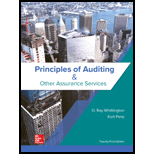
EBK PRINCIPLES OF AUDITING & OTHER ASSU
21st Edition
ISBN: 9781260299434
Author: WHITTINGTON
Publisher: YUZU
expand_more
expand_more
format_list_bulleted
Question
Chapter 14, Problem 26RQ
To determine
Explain the difference that the auditor would find between support evidence for accrued liabilities as contrasted with accounts payable.
Expert Solution & Answer
Trending nowThis is a popular solution!

Students have asked these similar questions
Need help in this problem qui
Use the following template to organize and present your results:
Almond Beach Inc.
Palm Beach Inc.
Theoretical CAPM Actual offered
prediction for
expected return
(x)
return (x)
Standard
deviation of
return (%)
Beta
Comments on the diversified investor's
choice
Comments on the
individual investor's
choice
Complete the table given below and compute the WACC from theinformation provided after the table template.
Chapter 14 Solutions
EBK PRINCIPLES OF AUDITING & OTHER ASSU
Ch. 14 - If a corporation overstates its earnings, are its...Ch. 14 - Prob. 2RQCh. 14 - Prob. 3RQCh. 14 - Prob. 4RQCh. 14 - Prob. 5RQCh. 14 - Prob. 6RQCh. 14 - Prob. 7RQCh. 14 - Prob. 8RQCh. 14 - List the major responsibilities of an accounts...Ch. 14 - Prob. 10RQ
Ch. 14 - Prob. 11RQCh. 14 - Prob. 12RQCh. 14 - Prob. 13RQCh. 14 - Prob. 14RQCh. 14 - Prob. 15RQCh. 14 - Prob. 16RQCh. 14 - Prob. 17RQCh. 14 - Whitehall Company records its liabilities in an...Ch. 14 - Prob. 19RQCh. 14 - Prob. 20RQCh. 14 - Prob. 21RQCh. 14 - Prob. 22RQCh. 14 - What is the purpose of the auditors review of cash...Ch. 14 - Prob. 24RQCh. 14 - Prob. 25RQCh. 14 - Prob. 26RQCh. 14 - Prob. 27QRACh. 14 - Prob. 28QRACh. 14 - Prob. 29QRACh. 14 - Prob. 30QRACh. 14 - Prob. 31QRACh. 14 - Prob. 32QRACh. 14 - Which of the following procedures is least likely...Ch. 14 - Prob. 33BOQCh. 14 - Which of the following is the best audit procedure...Ch. 14 - Prob. 33DOQCh. 14 - Prob. 33EOQCh. 14 - Prob. 33FOQCh. 14 - Prob. 33GOQCh. 14 - Prob. 33HOQCh. 14 - Ordinarily, the most significant assertion...Ch. 14 - Prob. 33JOQCh. 14 - Prob. 33KOQCh. 14 - Prob. 33LOQCh. 14 - Prob. 34OQCh. 14 - Prob. 35OQCh. 14 - Prob. 36OQCh. 14 - Prob. 37OQCh. 14 - Prob. 38PCh. 14 - Prob. 39PCh. 14 - Prob. 40PCh. 14 - Prob. 41PCh. 14 - Prob. 42PCh. 14 - Prob. 43ITC
Knowledge Booster
Similar questions
- please help me create a balance sheet and expalin (a) Lisa invested cash by making a deposit in a bank account for the business, $9,000. (b) Paid rent for July, $150. (c) Purchased a used van for cash, $5,000. (d) Purchased a laptop computer (Computer Equipment) on account for, $500. (e) Purchased cleaning supplies that cost $200. Paid $100 cash and will pay the balance next month, $100. (f) Paid part-time assistant (Salaries and Wages expense) for first half of month, $100. (g) Paid for advertising, $90. (h) Paid two-year premium for liability insurance on van, $480. (i) Received cash from clients for services performed, $800. (j) Performed cleaning services for clients on account, $500. (k) Paid phone bill, $40. (l) Received cash from clients for window cleaning performed on account in transaction (j), $200. (m) Paid part-time assistant for last half of month, $200. (n) Made partial payment on computer equipment purchased in transaction (d), $200. (o)…arrow_forwardNeed help in this problem can u doarrow_forwardHello tutor i need help in this problemarrow_forward
arrow_back_ios
SEE MORE QUESTIONS
arrow_forward_ios
Recommended textbooks for you
 Auditing: A Risk Based-Approach (MindTap Course L...AccountingISBN:9781337619455Author:Karla M Johnstone, Audrey A. Gramling, Larry E. RittenbergPublisher:Cengage Learning
Auditing: A Risk Based-Approach (MindTap Course L...AccountingISBN:9781337619455Author:Karla M Johnstone, Audrey A. Gramling, Larry E. RittenbergPublisher:Cengage Learning EBK CONTEMPORARY FINANCIAL MANAGEMENTFinanceISBN:9781337514835Author:MOYERPublisher:CENGAGE LEARNING - CONSIGNMENT
EBK CONTEMPORARY FINANCIAL MANAGEMENTFinanceISBN:9781337514835Author:MOYERPublisher:CENGAGE LEARNING - CONSIGNMENT Auditing: A Risk Based-Approach to Conducting a Q...AccountingISBN:9781305080577Author:Karla M Johnstone, Audrey A. Gramling, Larry E. RittenbergPublisher:South-Western College Pub
Auditing: A Risk Based-Approach to Conducting a Q...AccountingISBN:9781305080577Author:Karla M Johnstone, Audrey A. Gramling, Larry E. RittenbergPublisher:South-Western College Pub- Business/Professional Ethics Directors/Executives...AccountingISBN:9781337485913Author:BROOKSPublisher:Cengage
 Intermediate Accounting: Reporting And AnalysisAccountingISBN:9781337788281Author:James M. Wahlen, Jefferson P. Jones, Donald PagachPublisher:Cengage Learning
Intermediate Accounting: Reporting And AnalysisAccountingISBN:9781337788281Author:James M. Wahlen, Jefferson P. Jones, Donald PagachPublisher:Cengage Learning

Auditing: A Risk Based-Approach (MindTap Course L...
Accounting
ISBN:9781337619455
Author:Karla M Johnstone, Audrey A. Gramling, Larry E. Rittenberg
Publisher:Cengage Learning

EBK CONTEMPORARY FINANCIAL MANAGEMENT
Finance
ISBN:9781337514835
Author:MOYER
Publisher:CENGAGE LEARNING - CONSIGNMENT

Auditing: A Risk Based-Approach to Conducting a Q...
Accounting
ISBN:9781305080577
Author:Karla M Johnstone, Audrey A. Gramling, Larry E. Rittenberg
Publisher:South-Western College Pub


Business/Professional Ethics Directors/Executives...
Accounting
ISBN:9781337485913
Author:BROOKS
Publisher:Cengage

Intermediate Accounting: Reporting And Analysis
Accounting
ISBN:9781337788281
Author:James M. Wahlen, Jefferson P. Jones, Donald Pagach
Publisher:Cengage Learning